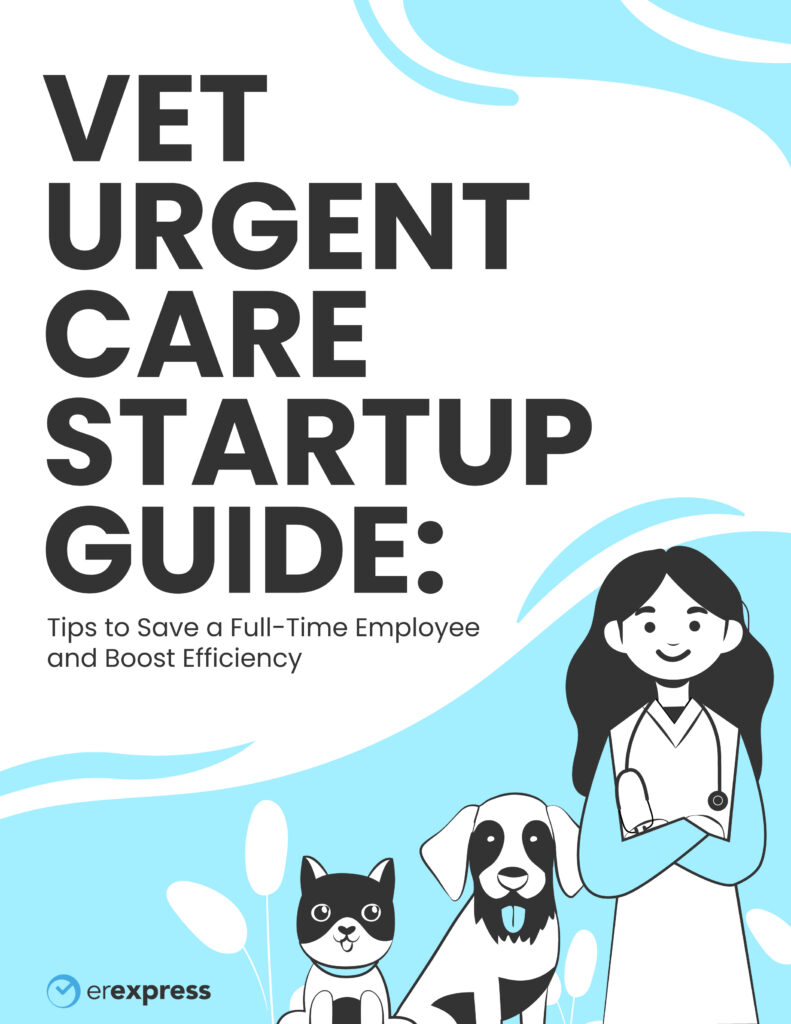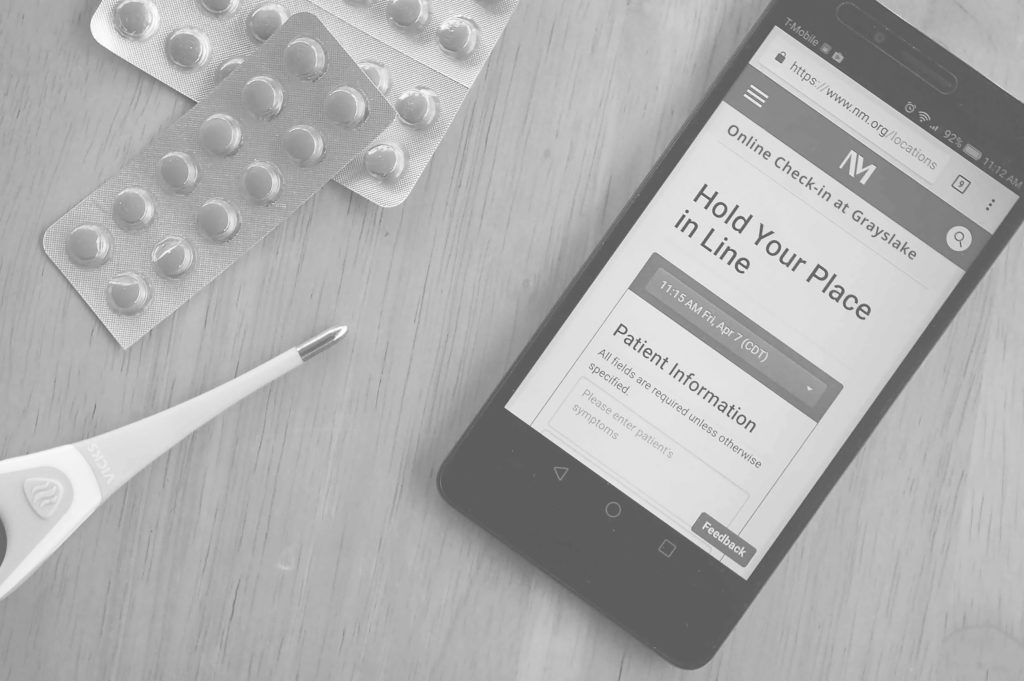
Tips to Save a Full-Time Employee and Boost Efficiency. Download your guide today!
Enter your name and email below to discover how you can meet a growing demand and improve pet owner satisfaction.
Today’s world is increasingly mobile and fast-paced so keeping up with the competition, delivering a better patient experience, and expanding an online services are often at or near the top of the list for many health systems. One of the best ways to hit all three marks is to offer patients the convenience of online scheduling, but most often walk-in facilities, especially emergency departments, are often overlooked.
We get it. Online patient scheduling (aka online check-in) seems at odds with the acuity-based nature of the ER. In fact we regularly hear four excuses from clients as to why online check-in won’t work for them. We’re out to prove that these excuses are just misconceptions and that online check-in is actually ideal for addressing many of the issues your emergency department faces on a regular basis.
Expanding on this, it’s important to recognize that online patient scheduling, may initially seem incompatible with the acuity-based nature of the ER. Despite initial hesitations, we consistently find that the benefits far outweigh any perceived drawbacks. In fact, many of the reservations expressed by clients stem from common misconceptions about online check-in. We’re here to debunk these myths and demonstrate how online check-in can significantly enhance the functioning of your emergency department.

1. The emergency room is for emergencies. If patients aren’t sick enough that they can check in online and wait at home, then they shouldn’t be going to the ER.
We agree! Unnecessary and avoidable ER utilization is a costly problem.
However, consider the percent of overall patient volume in your ED today that comprises of non-emergent, “fast-track” type of patients:
An online scheduling program is not designed to encourage more ED visits. Rather, it is a tool that gives the ED more control over patient arrival times and can reduce length of stay (LOS).
These low-acuity patients are likely to consider several different options via mobile device before deciding where to go. If it is after 5:00 pm, the choices are likely going to be limited visiting the emergency room or waiting until the next day. Having the convenience of online check-in on your website can help persuade these patients to choose your ED over a competitor’s ED while decongesting your waiting room because they will be able to do most of their waiting from home. So, this online check-in isn’t just a feature; it’s a smart move in the world of healthcare. It’s a way to make things easier for patients and helps your Emergency Department stand out. It’s like a director in a play, making sure everything goes smoothly and leaving a positive impression long after the wait is over.
If you have more than one location or even an urgent care facility you’d prefer to direct these patients to use, online scheduling can also help redirect patients to the facility that has more capacity to treat them. Your staff can simply block out times during your busiest hours and open up time slots when you are less busy to encourage more staggered arrival patterns.
2. Our IT department says our EMR already has online scheduling built-in. Why should we spend money on an outside vendor?
Many EMRs offer some form of patient scheduling, and while some offer a lot of useful features, many are tacked-on offerings with limited usefulness.
First, let’s unpack what “our EMR already does scheduling” means.
Does IT mean the patient portal (MyChart, etc.) can do “appointments?” Patient portals work well for patient-provider messaging and getting lab results (85% of patients who use the portal use it for getting lab results). The GAO cites that patient portal actual use tops at 30% of patients[1].
They have two big limitations: first, they usually require a username / password sign-in, which prevents new patients from using it. In other words, they do not do much for patient acquisition.
Second, they give your patients a clunky scheduling experience, especially on mobile devices (where 70%+ of your patients will want to book). Ask yourself: what percent of patients are using the portal regularly from a mobile device? Can MyChart even report this metric?
Other EMRs (such as Epic’s On My Way product) offer an actual walk-in scheduling tool. However, you are getting its first-generation product, while specialized vendors offer their 4th, 5th, or 6th generation product based on 5-10 years of focus on the scheduling category. The EMRs focus on what pays their bills – clinical charting, coding, and charge capture.
Specialty vendors focus on what pays their bills – an outstanding online scheduling system. If your EMR vendor fails to meet your online booking goals, you probably will not change EMRs. However, the specialty vendors know that their survival depends 100% on meeting your online booking goals.
ER Express will deliver a better product than your EMR for three big reasons:
3. Online check-in seems to be a good marketing tool but why do we need to market our ER – everyone knows us right?
Here’s something to consider: about 5% of all Google searches are healthcare related [2] and in the week leading up to a patient’s visit to the ER, their Google search history for health information doubles. About 15% of those patients end up searching for logistical information for nearby ERs [3]. If your ER is not showing up at the top of the Google search results page or you have a decent amount of competition in your area, it’s very likely that patients will choose a competing hospital.
Marketing the convenience of online check-in on your website, through Google Ads, display ads, etc. is not only going to help your emergency department to stand out, it’s going to make for a better patient experience overall. Instead of pushing for the popular option of advertising wait times, you have an actual benefit to advertise that can give patients more control over their time and comfort, while helping your staff redirect low-acuity visits to less busy times. It’s definitely better to get the word out about your online check-in service than to deal with unpredictable volume surges and unhappy patients who end up waiting longer than they expected. Think about it this way: without online check-in, you might face sudden rushes of patients, leaving some frustrated due to long waits. By spreading the word about your online check-in service, you’re not just being smart – you’re making it clear you care about your patient’s comfort. This approach helps things run more smoothly for everyone, creating a reliable and trustworthy environment for both patients and staff.
4. Our patients won’t use it. They are too old / poor / rural / old / uneducated (Based on actual comments we have heard from our customers).
This issue boils down to one simple fact: Do your patients have a phone?
The answer is almost certainly yes. If they have a mobile device, then they will be more likely use this service. Let’s look at the stats:[4]
Myth # 1: Our patients are too old to consider using this service.
Smartphone ownership by age indicates that phone ownership is still quite high.
Myth # 2: Lower-income patients will not use this kind of service
Smartphone ownership by income bracket shows that even at the lower-end socioeconomic status bracket (based on household income), the vast majority of your patients have some kind of mobile device.
Myth # 3: We are based in a rural area, and our patients don’t have smartphones. Or, flip side of the same coin: we are based in the inner city.
Smartphone ownership by location indicates that phone ownership does not vary as much as you might expect:
Myth # 4: We do not have a highly-educated patient population, so they are unlikely to use service that requires a phone.
Smartphone ownership by education level also indicates that across all education levels, your patients are quite likely to have a smart phone:
5. We’re low on staff. Adding this service will require too much training and effort to implement right now.
It may seem like adding a new initiative should wait until you have a full staffing. However, our program can actually reduce your workload and help your staff get more done.
Additionally, embracing online check-in demonstrates a commitment to embracing modern technology in the healthcare industry. In an era where convenience is valued more than ever, providing patients with the option to check in from the comfort of their homes or while on the go is a game-changer. It shows that your healthcare facility is attuned to the evolving needs and preferences of the community you serve.
The online check-in program staggers patient arrival times, which in turn reduces bottlenecks. Staff work tends to increase with bottlenecks, and likewise, decrease when you take away bottlenecks.
Moreover, an efficient online check-in system can significantly improve the overall patient experience. It minimizes the time spent in crowded waiting rooms, allowing individuals to have more control over their schedules.
Patients will appreciate the convenience and the respect for their time, which can lead to higher levels of patient satisfaction and loyalty. This positive experience can have a ripple effect, as satisfied patients are more likely to recommend your facility to others, contributing to a growing and thriving patient base.
Furthermore, implementing an online check-in service sets a precedent for a culture of innovation and adaptability within your healthcare practice. It shows that you are willing to explore new avenues to enhance the quality of care you provide.
This forward-thinking approach not only benefits patients but also boosts staff morale and productivity. When employees see that their workplace is invested in streamlining processes and prioritizing patient comfort, it fosters a positive and motivated work environment, ultimately leading to better outcomes for everyone involved.
Yes, this new service does require some initial training, but we make it as painless as possible by actually spending time on-site training your staff, understanding your specific needs and then customizing a workflow that works best for you.
[1] Patient Engagement Hit, July 2018
[2] Google Blog, February 2015.
[3] Penn Medicine News, February 2019.
[4] Pew Research Center, data collected in January – February 2019.
We are excited to announce that ER Express is now fully integrated with ezyVet! This powerful collaboration streamlines your practice management by seamlessly connecting ER Express’s online check-in and digital intake tools with ezyVet’s comprehensive veterinary software. Request a demo today to see how this integration can elevate your clinic’s efficiency and enhance the overall experience for your staff and clients.

Enter your name and email below to discover how you can meet a growing demand and improve pet owner satisfaction.
© ER Express. All rights reserved.